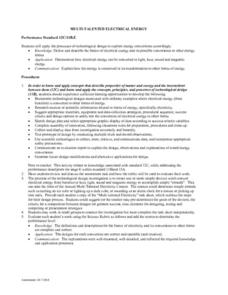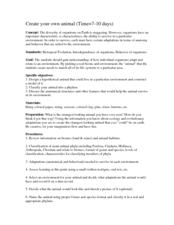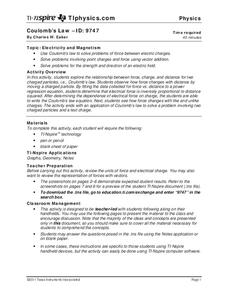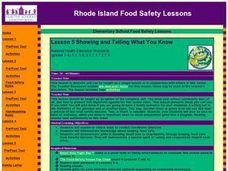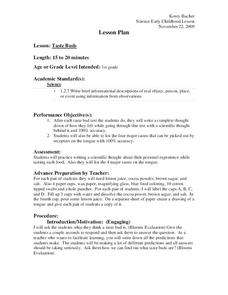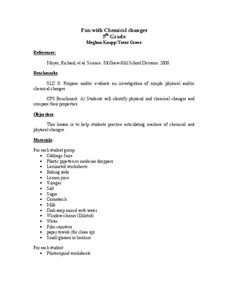Curated OER
Lead Extraction
Students investigate one method used in the detection of lead in the soil. They use a Lead Check Soil Kit to safely obtain results in 30 minutes or less in levels of 400 ppm or above. In addition, they write a brief description of what...
Curated OER
Quick Breads, Pancake/Waffle Lab
Middle schoolers explore the bread, cereal, grain food group on the Food Guide Pyramid. They test recipes for quick breads which are high in carbohydrates and determine the purpose of each of the ingredients in pancakes or waffles.
Curated OER
Building a Bridge
Third graders discover architecture and functionality by constructing a bridge. In this bridge engineering lesson, 3rd graders utilize cardboard, straws, towel tubes and plastic bottles to create a model bridge similar to ones seen...
Curated OER
Interdisciplinary Approach to Investigating Popcorn
Pupils conduct a lab experiment using the scientific method. In this interdisciplinary lesson plan, students will test the difference in popping white and yellow corn. Pupils will write their lab report in their science, math, history,...
Curated OER
Multi-Talented Electrical Energy
Students explore energy conversions by demonstrating the conversion of electrical energy into light, heat, sound, and magnetic energy. Students create a simple device that converts electrical energy from batteries to heat, light, sound...
Curated OER
Create Your Own Animal
Students design and create their own hypothetical animal. In this biology lesson plan, students identify the factors organisms need to survive. They classify their animals according to its correct phylum.
Curated OER
Math Analogies
In this math analogy worksheet, students complete the analogy by writing in the last item based on the relationship between the first two items.
Curated OER
Math Analogies
In this math analogy worksheet, students look at the pictures, determine the relationship of the first two and draw a picture to complete the mathematical analogy.
Curated OER
Is Organic Food Worth the Extra Cost?
Students calculate the amount of pesticide residue in selected foods for two
pesticides and determine if these levels are safe. They read an article about a
research study looking for metabolites of these pesticides in children. Finally,...
Curated OER
Creating the Model
Pupils comprehend what has been explored in the previous earthquake engineering design lessons, by putting their designs to the test.
They are given pairs a piece of paper, and an empty plastic bottle or can. Students stand the bottle...
Curated OER
Building Straw Towers
Students apply their knowledge of technology to help them build. For this science and technology lesson, students build straw towers and investigate the strength and form of the structure. They analyze the best design the make the...
Curated OER
On The Move
Fourth graders solve basic mathematical problems. They identify and apply key terms and equations relative to physical science. They discuss how train engines use fuel to move a generator, which creates electrical current that moves...
Curated OER
Coulomb's Law
Students solve problems involving electric charges and force. In this physics lesson plan, student solve word problems using addition and subtraction of vectors. They identify the direction represented by a vector as it relates to an...
Curated OER
The History of Maple Syrup
Students explore the process of harvesting maple syrup. In this science and history lesson, students make their own maple syrup and create a picture book that shows the Native American and American pioneer methods of making the syrup.
Curated OER
Does Your Chewing Gum Lose Its Flavor?
Students determine the amount of sugar in various types of gum. They chew a piece of gum until it loses its flavor and leave it to dry in order to weigh it and determine the amount of mass lost, and describe an experiment to determine...
Curated OER
What's in the Water?
Young scholars make a water sampler and use proper techniques to collect water.They write a essay explaining the inter-relationship of factors such as temperature, pH, dissolved oxygen, nitrates, and phosphates in a lake that might cause...
Curated OER
Chromotography
In this chromatography learning exercise, students are given markers, filter paper and a solvent to separate the pigments found in each marker. Students create a chromatogram for each marker.
Curated OER
Showing and Telling What You Know
Learners participate in activities to exhibit their knowledge of staying healthy by keeping food safe from harmful bacteria. In this bacteria free food lesson, students view a video and prepare a chart and present to others what...
Alabama Learning Exchange
Observation of Yeast Growth
Middle schoolers build an apparatus to look at how yeast cells grow by converting food to energy. They observe yeast both with and without food and see how yeast produces carbon dioxide.
Curated OER
Discovering Dichotomous Keys
Students become familiar with the structure and use of dichotomus keys. They demonstrate a comprehension of the fundamental principles of taxonomy by classifying organisms from a local ecosystem. Students are introduced to the term...
Curated OER
Taste Buds
First graders taste a variety of items and record a full sentence about the way they taste. In this taste buds lesson, 1st graders predict and then taste various items. Students draw a picture of the tongue and show the part...
Curated OER
Fun With Chemical Changes
Fifth graders observe and identify the differences between chemical and physical changes. In small groups they mix different substances together in glass beakers, and identify which had a chemical change, supporting their statements...
Curated OER
Mind Games
Students design a prototype game as they simulate being game designers for a major corporation. They base the game on the major body systems.
Curated OER
Building Challenges
Students work together to complete different building challenges. They use prior knowledge to build tunnels and different types of bridges. They share their creations with the group.






